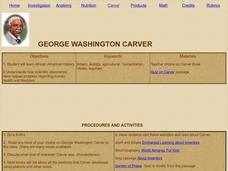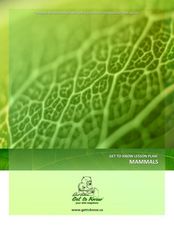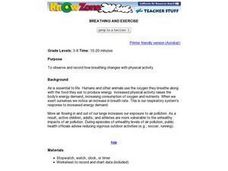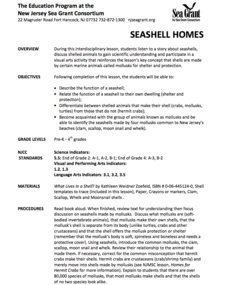Curated OER
Insects Are Helpful!
Students see that insects do lots good and are very valuable to humans and nature. This is part of an ongoing effort to dispel fears of insects. They rotate through a series of centers that have examples of how insects contribute to our...
Curated OER
George Washington Carver
Learners learn and research the life of George Washington Carver. In this historical figures instructional activity, students read a book on George Washington Carver, discuss his character and the challenges he faced in becoming a...
Curated OER
Colors
Students learn about the Impressionist painters' use of color and how it connected to early nineteenth century scientific theories about color. In this colors lesson plan, students explore combinations of primary and secondary colors,...
Curated OER
Learning About Plants- Flowers for a Special Occasion
Students explore the parts of plants and discover that plants need to grow. For this plant lesson, students discuss the parts of the plant and plant petunias. Students can share their plants with friends or families.
Curated OER
Get to Know: Mammals
Students discover the mammals in their community. In this animal lesson, students survey their school grounds for signs of mammals. Students examine tracks, droppings, and other signs of wildlife to learn more about the animals and their...
Curated OER
Adaptable Mandibles
Students define adaptation and highlight example of adaptation in birds and other animals. They study feeding techniques of seabirds and investigate the effect that trash has on wildlife.
Curated OER
The Things We Do
Fourth graders conduct a literature study in order to investigate the concept of change and how it occurs in the environment. The teacher uses the method of concept development for investigation.
Curated OER
Growing Coral
Students define the words coral and coral reef, and identify the Great Barrier Reef on a map or a globe. They observe crystal formations that develop in a way similar to the way coral polyps create their calcium carbonate cups.
Curated OER
Flawed Democracies, Human Rights
Pupils create drawing that tell a story about a young girl's life in an internment camp. In this internment camp lesson plan, students hear stories and analyze photographs of internment camps and then create their own drawings.
Curated OER
Methods of Mystery
Students utilize the scientific method to discover the age of an item. In this historical dating lesson plan, students compare and contrast a 400 year old cabinet to one made within a few years by using carbon dating. Students complete...
Curated OER
Water Conservation
Students investigate water conservation. In this water conservation lesson, students list the uses for water and record their water usage for one day. Students graph the data and create a water conservation poster.
Curated OER
Living in a Watershed
Fourth graders examine watersheds. In this ecosystem lesson, 4th graders discover what a watershed is and identify the local watershed they live in. Students investigate the attributes of a watershed as well.
Curated OER
Environment Vocabulary Quiz
In this environment vocabulary worksheet, students draw lines to match 13 words to their definitions in another column. Words pertain to the environment. Examples: biosphere, habitat, greenhouse effect, smog.
Curated OER
Ocean Vocabulary
In this vocabulary instructional activity, learners match words related to the ocean to their definitions. Worksheet is labeled as a quiz, but may be used as review/practice.
Curated OER
Tsunami Vocabulary Quiz
In this tsunami and earthquake words instructional activity, students draw lines to match 15 words that pertain to tsunamis with their definitions.
Curated OER
Breathing Rates and Exercise
Learners work in groups to predict which condition produces more breaths per minute. Groups record their breathing rates during rest periods and periods of activity. They graph their results and make comparisons to their predictions.
Curated OER
Exploring Simple Machines
Students investigate simple machines. In this simple machines instructional activity, students study how simple machines work. Students determine the function of various simple machines.
Curated OER
Electrical Circuits
Learners explore parallel and series circuits. In this electrical circuit lesson, students investigate the differences between series and parallel circuits. Learners observe the benefits and drawbacks of series and parallel circuits.
Curated OER
Discovering the Deep
Students explore the world's oceans. They research questions about the oceans and write a research report about an ocean animal. Students identify at least four different writing genres they experienced while reading about the ocean.
Curated OER
Seashell Homes
Pupils listen to a story about seashells. They discuss shelled animals. Learners describe the function of seashell. Pupils relate the function of a seashell to their own dwelling. They differentiate between shelled animals that make...
Curated OER
The Needs of Living Things
Learners watch video clips of animals and plants in their natural environment, to gather evidence that all living things have basic survival needs. Students draw pictures of real or imaginary pets eating, drinking, breathing, and taking...
Curated OER
Mellowing With Age, A Closer Look
Students realize that aging is a "natural, continuous process" and develop sensitivity to the needs, desires, and capabilities of the elderly by interviewing elderly community members and photographing age related things.
Curated OER
Insect Conservation
Students make a diorama. In this insect lesson plan, students review what they know and what they need to know about insects. Students define conservation, discuss why it is important to conserve insects, and make an insect diorama.
Curated OER
How Does a Green Plant Grow?
Students of all ages can explore the question "how do seeds grow?", design an experiment to answer the question, predict the outcome of the experiment then conduct the experiment.
Other popular searches
- K 2 Life Science Growth
- K 2 Life Science Living
- K 2 Life Science Insects
- K 2 Life Science Salamander
- K 2 Life Science Hibernation
- K 2 Life Science Adaptation
- K 2 Life Science Cells
- K 2 Life Science Nonliving
- K 2 Life Science Wind

























